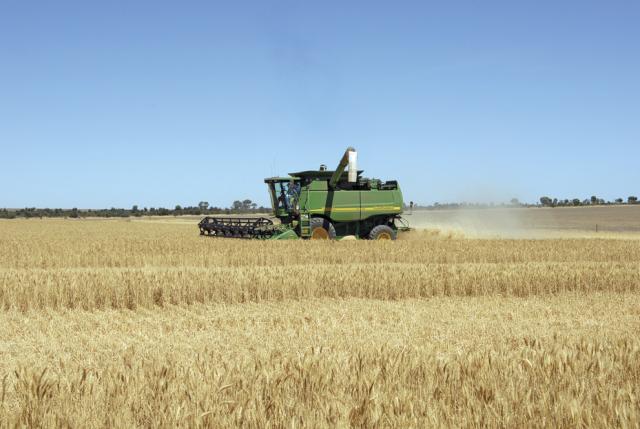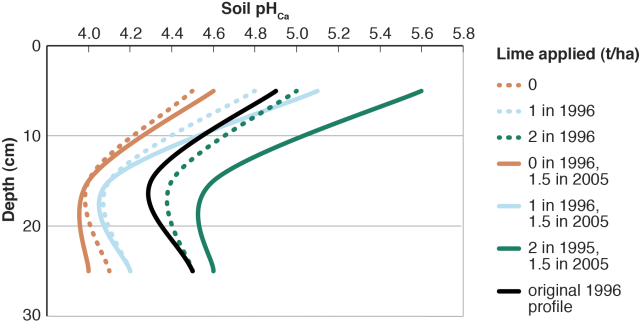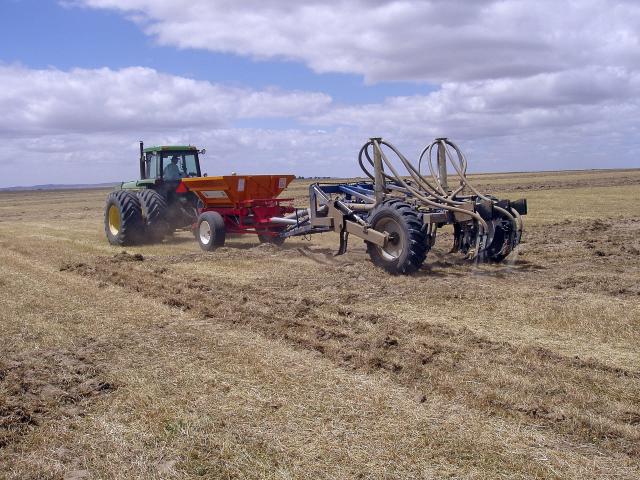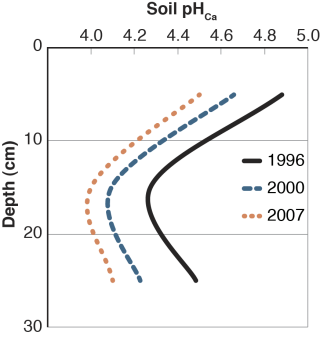Mal and Justin King, Bindi Bindi: surface and deep-placement liming

Property information
Average annual rainfall: 360mm
Enterprise mix: crop and pasture
Predominant soil types: deep sands and sandy duplex
Trial treatments
This trial was established in 1996 as a long-term DPIRD demonstration site on a sandy gravel soil. Plots 50m x 200m were treated with surface applications of 1 and 2t/ha of limesand. Control plots were unlimed and all treatments had three replications.
In 2005 the existing plots were further divided with new liming and deep ripping treatments to test the value of placing lime in the subsurface using modified deep-ripping equipment. A shallow leading tine ripper coupled to a multi-spreader with a venturi distribution system was used to place lime in the subsurface.
The leading tine placed lime at 15-20cm and the following tine placed lime at 20-25cm. Tine spacing was 450mm (Figure 1).
The new treatments were:
- no extra lime added to the original treatments, not deep-ripped
- no extra lime added to the original treatments, deep-ripped to 25cm
- surface application of 1.5t/ha lime, not deep-ripped
- 1.5t/ha lime deep-placed during deep ripping to 25cm
The trial was managed by Mal and Justin King as part of normal paddock operations.
Impact of surface-liming
Soil pH
Initially, the soil pH profile was below targets of pHCa 5.5 in the surface and 4.8 in the subsurface and required liming to recover the 0-10, 10-20 and 20-30cm layers to the appropriate pH and prevent aluminium toxicity in the subsurface.
The impact of agriculture on soil pH is clearly demonstrated by comparing the pH in the unlimed plots over time (Figure 2). Where no lime was applied the soil profile continued to acidify and by 2000 was well below appropriate pH. By 2007, eleven years of farming without liming had resulted in a severely acidic profile.
Application of 1t/ha of lime in 1996 improved surface pH for a few years but was insufficient to prevent the subsurface from acidifying and by 2004 the whole profile was below target pH. When the pH was measured in 2007 the additional 1.5t/ha of lime that was surface-applied in 2005 had only improved the surface pHCa to 5.1 which was still below target and insufficient to recover the subsurface pH which remained severely acidic (Figure 3).
Where insufficient lime was applied, the soil pH profile was not sufficiently improved to give a return on investment considering the cost of liming.

In 2007, having been above the topsoil target pH for many years, the soil pH for the plots limed at 2t/ha in 1996 was back to the pH levels before liming, indicating that the applied lime had been completely used. Re-liming the 2t/ha plots with 1.5t/ha in 2005 resulted in the soil pH being above target in the topsoil and above critical (pHCa 4.5) in the subsurface by 2007 (Figure 3).
Additional lime would have been needed in the following few years to counter ongoing acidification and bring the subsurface soil to target pH. Applying lime early was an advantage. Although insufficient, applying 1t/ha lime in 1996 had more impact on soil pH in 2007 than applying 1.5t/ha in 2005.
Soil aluminium
Soil pH was a good predictor of aluminium levels (Table 1). As a rule of thumb, aluminium concentration less than two parts per million (ppm) is nontoxic, 2-5ppm is toxic to sensitive species and greater than 5ppm is toxic to tolerant species. In 2007, even in plots where the largest amount of lime had been applied, the subsurface soil was below the target of pHCa 4.8 and the aluminium concentration was 2ppm or above.
This would restrict the choice of crop and pasture species to tolerant varieties to avoid inhibited root growth. In the plots where no lime or only 1.5t/ha had been applied in 2005, the lower pH resulted in aluminium concentrations that were toxic and would have inhibited root growth, even in tolerant species and varieties.
| Surface-applied lime (t/ha) | Soil depth (10-20cm) | Soil depth (10-20cm) | Soil depth (20-30cm) | Soil depth (20-30cm) |
|---|---|---|---|---|
| N/A | pHCa | Al (ppm) | pHCa | Al (ppm) |
| 0 | 4.0 | 7 | 4.1 | 7 |
| 0 in 1996 + 1.5 in 2005 | 4.0 | 9 | 4 | 8 |
| 1 in 1996 | 4.1 | 4 | 4.2 | 3 |
| 1 in 1996 + 1.5 in 2005 | 4.1 | 5 | 4.2 | 4 |
| 2 in 1996 | 4.4 | 2 | 4.5 | 2 |
| 2 in 1996 + 1.5 in 2005 | 4.6 | 3 | 4.6 | 2 |
Wheat yield
Wheat grain yield was measured in 1996, 1998, 2004, 2007 and 2009 (Table 2). Surface-applied lime does not usually change soil pH sufficiently in the year of liming to produce a yield response and this was the case in this trial. In subsequent years, the plots limed at 2t/ha in 1996 yielded 10-20% more than the unlimed plots.
A basic economic analysis showed the cumulative benefit of the 1996 2t/ha lime treatment from five years of wheat to be $425/ha. The benefit of the additional 1.5t/ha applied in 2005 from two wheat rotations was $250/ha (Table 2).
| Year | Wheat yield (t/ha) | Yield increase (%) | Benefit ($/ha)* | ||||
|---|---|---|---|---|---|---|---|
| N/A | No lime | 2t/ha lime | 2+1.5t/ha lime | 2t/ha lime | 2+1.5t/ha lime | 2t/ha lime | 2+1.5t/ha lime |
| 1996 | 2.2 | 2.2 | N/A | 0 | N/A | 0 | N/A |
| 1998 | 1.6 | 1.8 | N/A | 11 | N/A | 50 | N/A |
| 2004 | 2.5 | 3.2 | N/A | 22 | N/A | 175 | N/A |
| 2007 | 2.6 | 2.9 | 2.9 | 10 | 10 | 75 | 75 |
| 2009 | 2 | 2.5 | 2.7 | 20 | 26 | 125 | 175 |
The benefits of roots being able to grow uninhibited into the subsoil varies from season to season. In years where water is not limiting there will be less benefit. In the majority of seasons plants rely on stored subsoil water which deeper roots are able to access at the end of the season.
Pasture response to liming
Pasture biomass was measured in 2005. The biomass was 70% greater in the 2t/ha lime treatment plot than the unlimed plot. This improvement would have been as a result of improved nodulation of the legume-based pasture and improved availability of nutrients in the topsoil where the pH was appropriate.
Impact of deep-placing lime
Deep-placing lime into the soil using the modified deep-ripper leads to a highly variable soil pH profile because the lime is not thoroughly mixed with the soil. The lime ends up in uneven but reasonably continuous sausage-shaped seams of limed soil through the depth of incorporation.
When done correctly, deep-placed lime provides pathways of higher pH soil through the acidic soil to better (more alkaline) soil below. In this case soil sampling to test the pH usually does not reflect the complete impact of liming. The impact of effective deep-placement of lime in improving the acidic soil profile can be seen in productivity and yield improvements.
In this trial, deep-placement was only beneficial in the previously unlimed plots (Figure 4). These plots had the most severe subsurface acidity constraint.
In 2007, the plots that received 2t/ha of lime in 1996 yielded the most wheat grain, regardless of subsequent liming or ripping treatments. In the previously unlimed plots, deep-placing 1.5t/ha of lime in 2005 increased wheat yield to almost as much as the plots that received 2t/ha lime in 1996.
In 2009, the differences in yield between the 1996 treatments were greater and the plots with the best soil pH profile yielded the most grain; 2t/ha of lime in 1996 plus 1.5t/ha in 2005. Again in 2009, the deep-placed lime improved wheat yield in the previously unlimed plots but only to around the same as the plots limed at 1t/ha in 1996.
Conclusions
The trial site had continued to acidify under a crop and annual pasture rotation where no lime had been applied which resulted in a severely acidic soil profile. In 2007, this site would have required 5-7t/ha of high quality lime over the next 10 years to recover the profile to target pH. Additional costs as a result of ongoing productivity losses would be incurred during the recovery phase.
In contrast, there was a large benefit in the long term from applying sufficient lime in 1996 and then re-applying lime in 2005.
The earlier lime can be applied, the better. Lost productivity and future cost of pH amelioration need to be considered in the medium to long term when making decisions about investing in liming.
If you have very acidic subsurface soil it may be worthwhile incorporating lime to provide pathways of improved soil pH through which roots can grow. The deep-placement method used in this trial is very difficult to get right and of no value if you don't.
Other methods such as rotary spading are probably more suitable. For further information about strategies to incorporate lime to depth see Applying lime.



